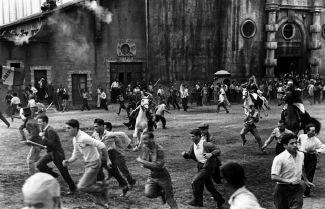
I MISERABILI
(Caccia all'uomo, Tempesta a Parigi, Italia/1948) R.: Riccardo Freda. D.: 188'. V. italiana
Sog.: dal romanzo omonimo di Victor Hugo. Scen.: Riccardo Freda, Mario Monicelli, Steno, Nino Novarese. F.: Rodolfo Lombardi. M.: Otello Colangeli. Scgf.: Guido Del Re. Mus.: Alessandro Cicognini. Int.: Gino Cervi (Jean Valjean), Valentina Cortese (Cosetta, Fantine), Andreina Pagnani (Suor Simplicia), Giovanni Hinrich (Aldo Nicodemi), Aldo Nicodemi (Marius), Ugo Sasso (il capo dei rivoluzionari), Marcello Mastroianni (un rivoluzionario), Gabriele Ferzetti (l'amante di Fantine). Prod.: Carlo Ponti per Lux Film 35mm. D.: 188'. Bn. Versione italiana / Italian version. Da: CSC - Cineteca Nazionale
Avevo letto molto il romanzo di Hugo dall'infanzia in poi e avevo un certo numero di idee che avevo proposto ai miei sceneggiatori, Novarese, Steno e Monicelli. Come ogni volta, ci siamo scambiati le nostre visioni del romanzo. Per me, adattare Hugo era abbastanza facile perché è un grande sceneggiatore: i personaggi e i dialoghi esistono e le scenografie sono descritte. Nell'insieme, sono rimasto molto fedele al romanzo, quanto meno nell'evoluzione della storia. Ma per me, Valjean doveva essere un eroe e non un personaggio gravato dal proprio passato. Lui non pone questioni metafisiche, non riflette sul senso del bene e del male, fa quello che vuole. Il mio film comincia volontariamente come un western con gli ingredienti classici: spari, arresto di Valjean e tentativo di evasione. Fino alla fine del racconto, il mio Valjean agisce come crede giusto, non cerca di redimersi. Di fronte a tutta la miseria umana descritta da Hugo, volevo un raddrizzatore di torti, come l'Aquila Nera o più tardi Casanova o Maciste.
Riccardo Freda in Eric Poindron, Riccardo Freda, un pirate à la caméra. Entretiens, Institut Lumière - Actes Sud, Arles 1994
I Miserabili di Freda è anzitutto un'opera dinamica in continua progressione, come una foresta di destini in marcia, tra i quali spicca la figura di un Jean Valjean che il regista ha voluto il meno possibile moralizzatrice. Questo movimento generale del film tiene in gran conto il rapporto di ciascun personaggio con il suo spazio, colto da una macchina da presa quantomai viva e dallo sguardo acuto del cineasta. Il modo in cui Jean Valjean abbraccia lo spazio della cava quando prepara l'evasione; il modo in cui Fantine guarda la piazzetta innevata dove andrà a 'lavorare'; il modo in cui Cosette guarda e teme lo spazio degli adulti, visto da sotto il tavolo dove è solita rifugiarsi; il modo in cui Javert si vede improvvisamente separato dal mondo e da se stesso come attraverso una grata prima di andare a buttarsi nella Senna: ecco alcune domande la cui risposta, inscritta nella messinscena, alimenta il movimento incessante del racconto. Film falsamente ricco, questa versione dei Miserabili prodotta dalla Lux ha potuto contare su un budget relativamente ridotto che spesso ha stimolato l'immaginazione del regista e talvolta l'ha frenata.
Jacques Lourcelles, Dictionnaire du cinéma. Les films, Robert Laffont, Paris 1992
I had read Hugo's novel a lot from childhood onwards, and I had suggested a certain number of ideas to my screenwriters, Novarese, Steno and Monicelli. As always, we shared our visions of the novel. In my opinion, adapting Hugo was rather easy because he is a great screenwriter: the characters and dialogue are there, and the sets are described. On the whole, I was faithful to the novel, at least in the story's evolution. But I felt Valjean was supposed to be a hero and not a character burdened by his past. He does not ask metaphysical questions nor reflect on the meaning of good and evil; he does what he wants. My film deliberately begins with the classic ingredients of a Western: shooting, Valjean's arrest and his attempt to escape. Up until the story's end, my Valjean acts as he wishes and never tries to redeem himself. Within all the human misery described by Hugo, I wanted a rectifier of wrongs, like the Black Eagle or, later on, Casanova or Maciste".
Riccardo Freda in Eric Poindron, Riccardo Freda, un pirate à la caméra. Entretiens, Institut Lumière - Actes Sud, Arles 1994
Freda's Les Misérables is first and foremost a dynamic work in continual progression, like a forest of destinies on the march, where Jean Valjean stands out, as the director wanted as little moralizing as possible. This general movement of the film values each character's relationship with his or her surroundings, captured by what seems to be an extremely alive camera and the sharp eye of the filmmaker. The way in which Jean Valjean embraces the space in the quarry as he prepares to escape; the way in which Fantine looks at the snow-covered square where she will go to 'work'; the way in which Cosette fears the adults' space, which she sees from under the table where she usually escapes; the way in which Javert sees himself as if through a grate, suddenly separated from the world, before throwing himself into the Seine: here are some of the questions the answers to which, written into the production, foster the story's incessant movement. This film is only apparently expensive, infact this version of Les Misérables produced by Lux was backed by a relatively low budget which often stimulated the director's imagination but sometimes blocked it.
Jacques Lourcelles, Dictionnaire du cinéma. Les films, Robert Laffont, Paris 1992
Tariffe:
Aria condizionata
Info: 051224605











